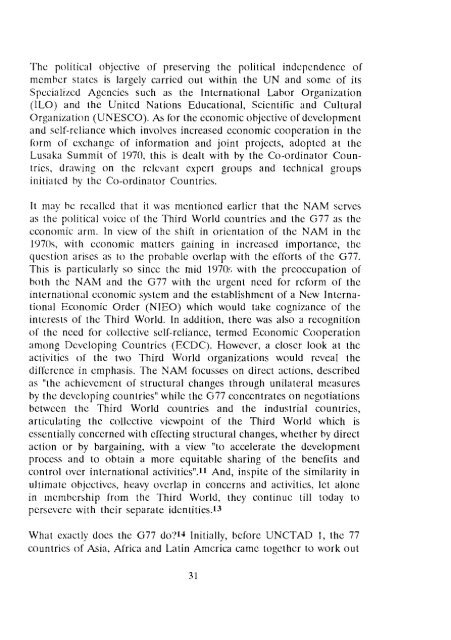ifda dossier 74 - Dag Hammarskjöld Foundation
ifda dossier 74 - Dag Hammarskjöld Foundation
ifda dossier 74 - Dag Hammarskjöld Foundation
You also want an ePaper? Increase the reach of your titles
YUMPU automatically turns print PDFs into web optimized ePapers that Google loves.
The political objective of preserving the political independence of<br />
member states is largely carried out within the UN and some of its<br />
Specialized Agencies such as the International Labor Organization<br />
(ILO) and the United Nations Educational, Scientific and Cultural<br />
Organization (UNESCO). As for the economic objective of development<br />
and self-reliance which involves increased economic cooperation in the<br />
form of exchange of information and joint projects, adopted at the<br />
Lusaka Summit of 1970, this is dealt with by the Co-ordinator Coun-<br />
tries, dmwing on the relevant expert groups and technical groups<br />
initiated by the Coordinator Countries.<br />
It may be recalled that it was mentioned earlier that the NAM serves<br />
as the political voice of the Third World countries and the G77 as the<br />
economic arm. In view of the shift in orientation of the NAM in the<br />
1970s, with economic matters gaining in increased importance, the<br />
question arises as to the probable overlap with the efforts of the G77.<br />
This is particularly so since the mid 1970;i with the preoccupation of<br />
both the NAM and the G77 with the urgent need for reform of the<br />
international economic system and the establishment of a New Interna-<br />
tional Econonlic Order (NIEO) which would take cognizance of the<br />
interests of the Third World. In addition, there was also a recognition<br />
of the need for collective self-reliance, termed Economic Cooperation<br />
among Developing Countries (ECDC). However, a closer look at the<br />
activities of the two Third World organizations would reveal the<br />
difference in emphasis. The NAM focusscs on direct actions, described<br />
as "the achievement of structural changes through unilateral measures<br />
by the developing countries" while the G77 concentrates on negotiations<br />
between the Third World countries and the industrial countries,<br />
articulating the collective viewpoint of the Third World which is<br />
essentially concerned with effecting structural changes, whether by direct<br />
action or by bargaining, with a view "to accelerate the development<br />
process and to obtain a more equitable sharing of the benefits and<br />
control over international activities".11 And, inspite of the similarity in<br />
ultimate objectives, heavy overlap in concerns and activities, let alone<br />
in membership from the Third World, they continue till today to<br />
persevere with their separate identities.13<br />
What exactly does the G77 do?l-Ã Initially, before UNCTAD 1, the 77<br />
countries of Asia, Africa and Latin America came together to work out
















